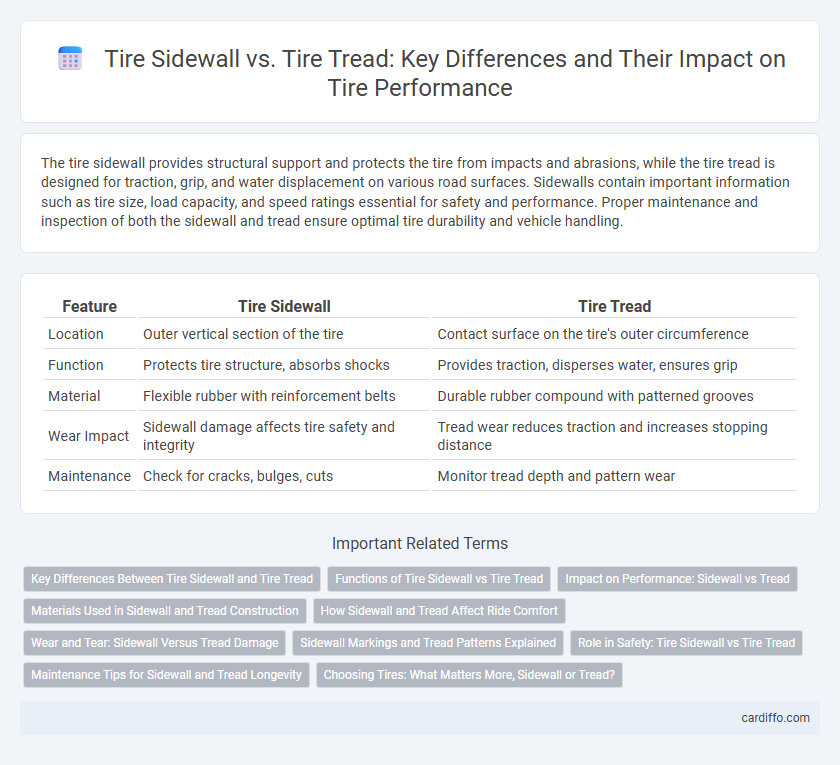The tire sidewall provides structural support and protects the tire from impacts and abrasions, while the tire tread is designed for traction, grip, and water displacement on various road surfaces. Sidewalls contain important information such as tire size, load capacity, and speed ratings essential for safety and performance. Proper maintenance and inspection of both the sidewall and tread ensure optimal tire durability and vehicle handling.
Table of Comparison
| Feature | Tire Sidewall | Tire Tread |
|---|---|---|
| Location | Outer vertical section of the tire | Contact surface on the tire's outer circumference |
| Function | Protects tire structure, absorbs shocks | Provides traction, disperses water, ensures grip |
| Material | Flexible rubber with reinforcement belts | Durable rubber compound with patterned grooves |
| Wear Impact | Sidewall damage affects tire safety and integrity | Tread wear reduces traction and increases stopping distance |
| Maintenance | Check for cracks, bulges, cuts | Monitor tread depth and pattern wear |
Key Differences Between Tire Sidewall and Tire Tread
The tire sidewall is the outermost layer that provides structural support, protects against impacts, and displays essential information such as tire size, load rating, and speed rating. In contrast, the tire tread is the rubber surface that contacts the road, designed with patterns to enhance traction, water dispersion, and overall handling. Sidewalls primarily focus on durability and protection, while treads prioritize grip and performance in various driving conditions.
Functions of Tire Sidewall vs Tire Tread
The tire sidewall provides structural support, protects the internal components, and absorbs shocks from road irregularities, ensuring ride comfort and durability. The tire tread is designed to maximize traction by channeling water, improving grip on different surfaces, and enhancing braking and handling performance. Together, the sidewall and tread maintain vehicle safety and efficiency under various driving conditions.
Impact on Performance: Sidewall vs Tread
The tire tread directly influences traction, handling, and braking performance by maintaining contact with the road surface, with different tread patterns optimized for various conditions like wet, dry, or off-road driving. The sidewall affects ride comfort, stability, and cornering ability by providing flexibility and absorbing shocks, with stiffer sidewalls enhancing responsive handling but potentially reducing comfort. Understanding the balance between tread design and sidewall construction is crucial for optimizing tire performance based on driving needs and conditions.
Materials Used in Sidewall and Tread Construction
Tire sidewalls are primarily constructed using flexible rubber compounds combined with fabric layers such as polyester or nylon to provide strength and resistance to impact and abrasion. In contrast, tire treads incorporate harder rubber compounds mixed with carbon black or silica to enhance grip, durability, and wear resistance on various road surfaces. The distinct material compositions and reinforcements in sidewalls and treads are engineered to balance flexibility, traction, and protection during tire operation.
How Sidewall and Tread Affect Ride Comfort
The tire sidewall plays a crucial role in absorbing shocks from road irregularities, directly impacting ride comfort by cushioning impacts and reducing vibrations. The tire tread, designed primarily for traction and handling, influences how the tire grips the road surface, which can affect stability and smoothness during driving. A taller, more flexible sidewall enhances comfort by allowing more absorption, while a thicker tread pattern provides better grip but may slightly increase road noise and firmness.
Wear and Tear: Sidewall Versus Tread Damage
Tire tread experiences significant wear and tear due to constant contact with road surfaces, affecting traction and safety, while sidewall damage is less common but often more critical, leading to potential blowouts or sidewall failure. Tread wear indicators provide measurable signs of tread degradation, whereas sidewall damage, such as cuts or bulges, usually requires immediate inspection and repair or replacement. Prioritizing tread depth maintenance extends tire lifespan, but monitoring sidewall integrity is essential to prevent hazardous driving conditions.
Sidewall Markings and Tread Patterns Explained
Tire sidewall markings provide critical information such as tire size, load index, speed rating, and manufacturing details, ensuring proper tire selection and safety compliance. Tire tread patterns are designed to optimize traction, water evacuation, and wear resistance, directly impacting vehicle handling and performance under various road conditions. Understanding both sidewall markings and tread patterns is essential for selecting the right tire to match driving needs and maintain optimal safety standards.
Role in Safety: Tire Sidewall vs Tire Tread
The tire tread provides essential traction by making direct contact with the road surface, ensuring grip during acceleration, braking, and cornering to prevent skidding and hydroplaning. The tire sidewall contributes to safety by maintaining structural integrity, absorbing shocks, and protecting the tire from impacts and abrasions, which helps prevent blowouts. Together, the tread and sidewall work to maximize vehicle control and durability, directly impacting overall driving safety.
Maintenance Tips for Sidewall and Tread Longevity
Regularly inspect tire sidewalls for cracks, cuts, or bulges to prevent potential blowouts and ensure vehicle safety. Maintain proper tire pressure to reduce uneven tread wear and extend the lifespan of both the sidewall and tread. Rotate tires every 5,000 to 8,000 miles to promote even tread wear and avoid premature sidewall damage.
Choosing Tires: What Matters More, Sidewall or Tread?
The tire tread plays a critical role in traction, handling, and water dispersion, directly impacting vehicle safety and performance. The sidewall influences ride comfort, tire durability, and the ability to absorb road shocks, which is essential for driving stability. When choosing tires, prioritize tread design for grip and conditions, while considering sidewall strength for load capacity and ride quality.
Tire sidewall vs Tire tread Infographic

 cardiffo.com
cardiffo.com